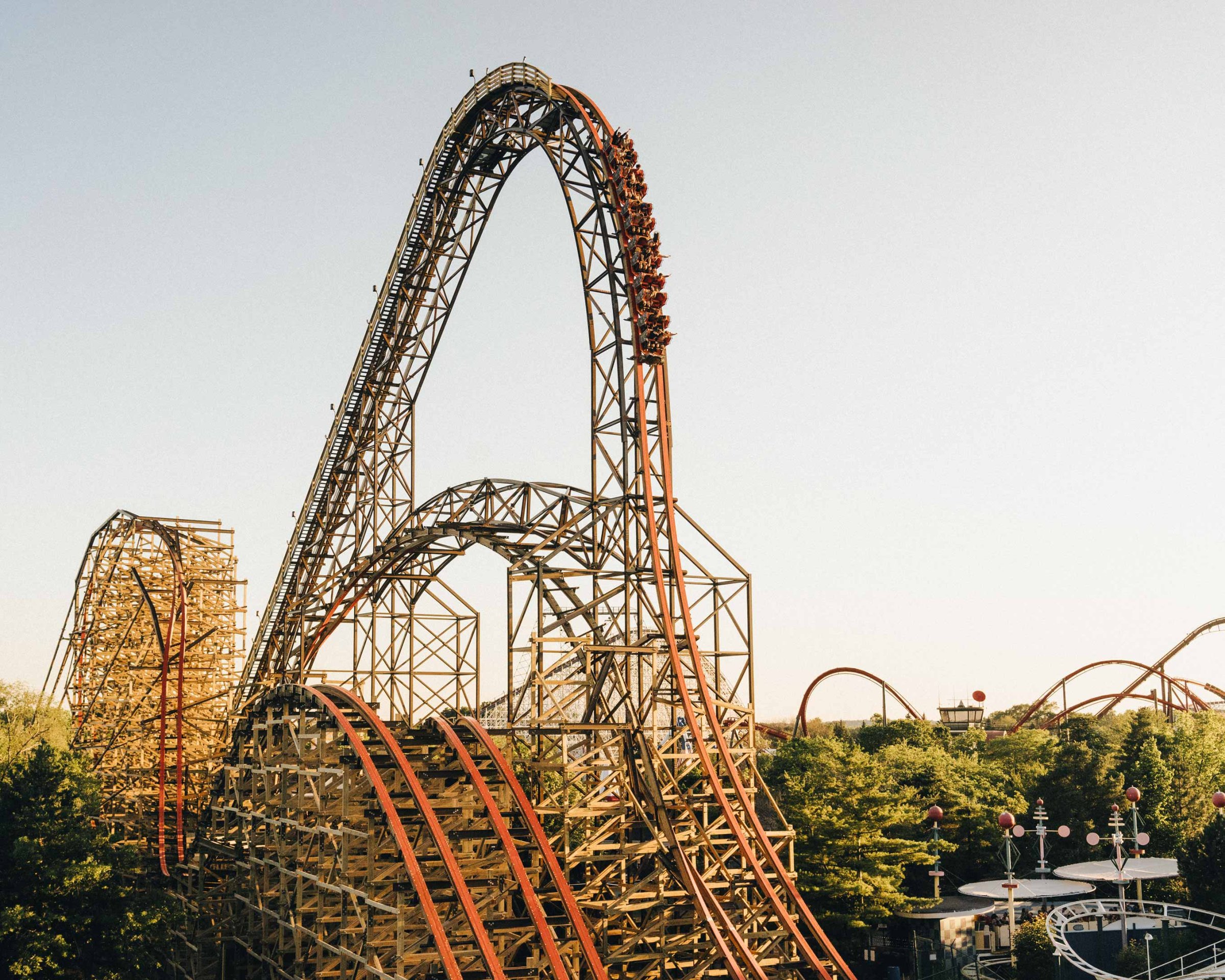
Goliath may have cost millions to build, but it doesn’t look very sturdy. From my hotel in Gurnee, Ill., an hour north of Chicago, I can see it: 15 stories tall and constructed of wooden beams that, from a distance, appear as spindly as toothpicks. When it opened in June at Six Flags Great America, Goliath broke three world records for wooden roller coasters: the tallest drop (180 ft.), the steepest drop (85 degrees) and the fastest speed (72 m.p.h.). Steel roller coasters eclipse these figures, but many amusement-park purists swear by the rickety charms of old-fashioned wooden rides. The look is dangerous–like it could collapse in an instant. For adrenaline junkies, there’s no finer catnip.
When I get to the park, I sit in the front row of Goliath’s cherry red train next to a boy no older than 8. “Are you scared?” I ask him.
“No,” he says defensively. A moment’s hesitation. “Not really.” But by the time we’ve ascended to the apex of a 165-ft. hill, we’re both screaming.
This summer, America’s newest roller coasters are testing the boundaries of height and speed, all in pursuit of scaring the pants off their riders. You loop through furious inversions (the term for the part of the track that turns riders upside down), plummet down dizzying drops of hundreds of feet or veer perilously close to an object on the track to experience the illusion of an inevitable collision before swerving to safety just in time. Technical innovations–largely led by an Idaho-based company called Rocky Mountain Construction, which built Goliath–have made it possible to erect wooden coasters that approach the daunting scale of their steel counterparts. Meanwhile, Swiss firms like Bolliger & Mabillard have developed new thrill rides like the wing coaster, which seats riders on either side of a track with nothing above or below: it feels like flight, hurtling through the air at a breathtaking velocity.
While there’s little question that the biggest rides are getting scarier, judging their safety is more complicated. Consistent numbers on incidents are tough to come by, because no single government agency is responsible for amusement-park safety. A study conducted for an industry group, the International Association of Amusement Parks & Attractions, found that there were 4.3 injuries for every million park attendees in 2011; the study used data from 383 parks. Still, the industry has faced a few high-profile tragedies, like the death of a 52-year-old woman thrown from a roller coaster at Six Flags Over Texas in Arlington in 2013. As recently as July 7, 22 people were trapped on a coaster at Six Flags Magic Mountain in Valencia, Calif., and some of them were treated for injuries.
Growth in visitors to amusement parks has been lackluster, with annual attendance hovering at around the 300 million mark in recent years, according to industry sources. That makes the coaster arms race critical for parks that are competing to attract summer crowds and justify hefty ticket prices. At Six Flags Great Adventure in Jackson, N.J., where a full-price day pass now costs $66.99 for an adult, up 6% from last year, one of the big draws is Zumanjaro–a drop ride attached to the record-breaking steel roller coaster Kingda Ka–where riders fall 415 ft. at 90 m.p.h. in the span of 10 seconds. GateKeeper at Cedar Point in Sandusky, Ohio, boasts the world’s highest inversion, turning riders upside down at 170 ft. Kings Island park in Mason, Ohio, has Banshee, the world’s longest inverted roller coaster, where the train hangs beneath the track, leaving riders’ legs dangling. If a new roller coaster doesn’t break records, it isn’t worth building.
That trend is likely to continue. “We don’t feel we’re anywhere close to the boundaries,” says Alan Schilke, the designer of Goliath. “We can break a new record every year.”
It’s a terrifying thing to consider, especially halfway through the mighty Goliath, since I’m convinced I’ve made a terrible mistake in riding it. After that astonishing first drop, there’s one head-spinning inversion, some wild lurching and then a zero-gravity stall in which the car is suspended upside down, giving the surreal feeling of weightlessness. I’m in a state of delirious half-blackout for most of the ride, screaming myself hoarse. What kind of lunatic would willingly get on this thing? I wonder.
But as the track flattens and we slow to a halt, the adrenaline settles. My heart rate slows. My euphoria passes. I look longingly back up at Goliath.
I ride it again.
More Must-Reads From TIME
- The 100 Most Influential People of 2024
- The Revolution of Yulia Navalnaya
- 6 Compliments That Land Every Time
- What's the Deal With the Bitcoin Halving?
- If You're Dating Right Now , You're Brave: Column
- The AI That Could Heal a Divided Internet
- Fallout Is a Brilliant Model for the Future of Video Game Adaptations
- Want Weekly Recs on What to Watch, Read, and More? Sign Up for Worth Your Time
Contact us at letters@time.com